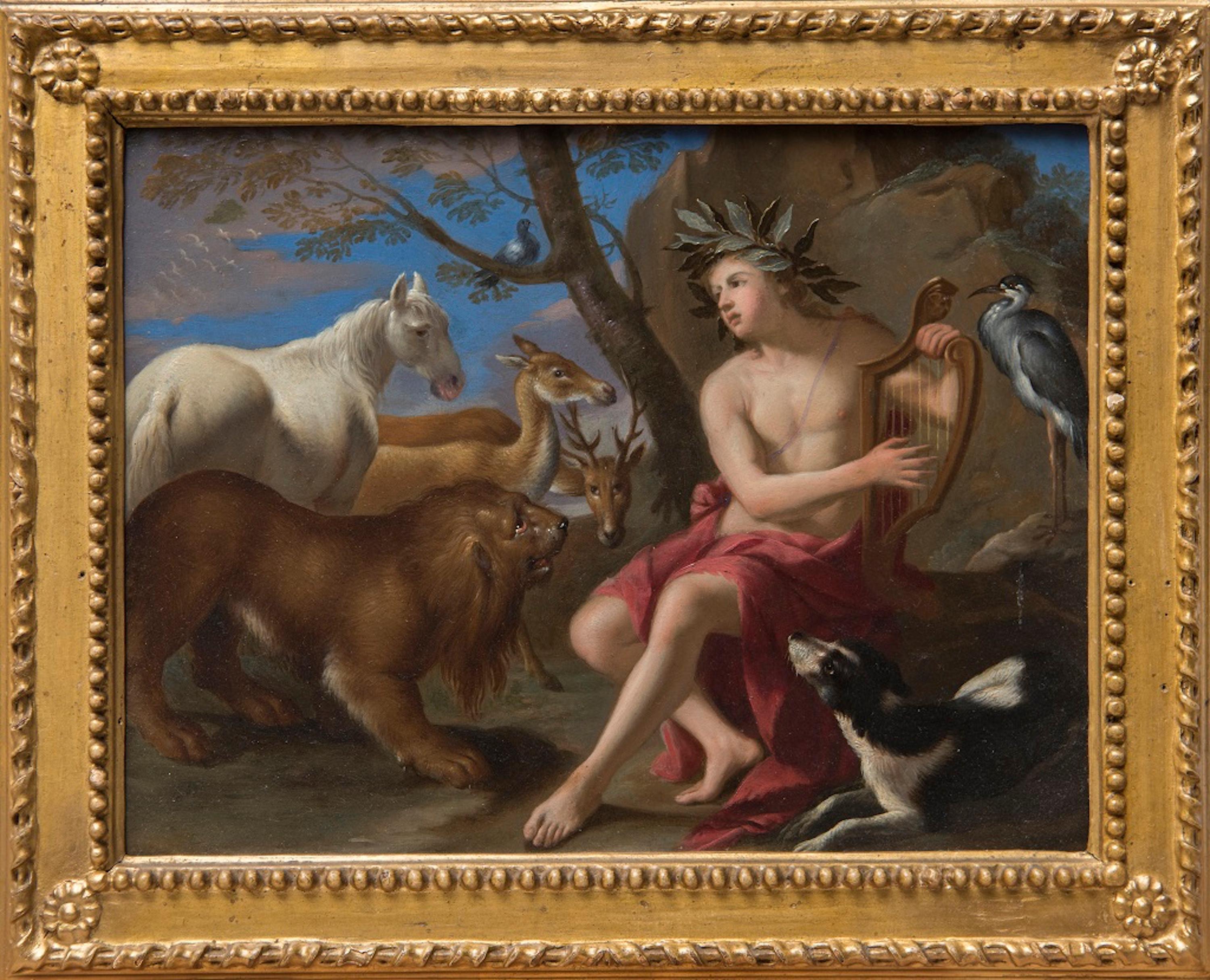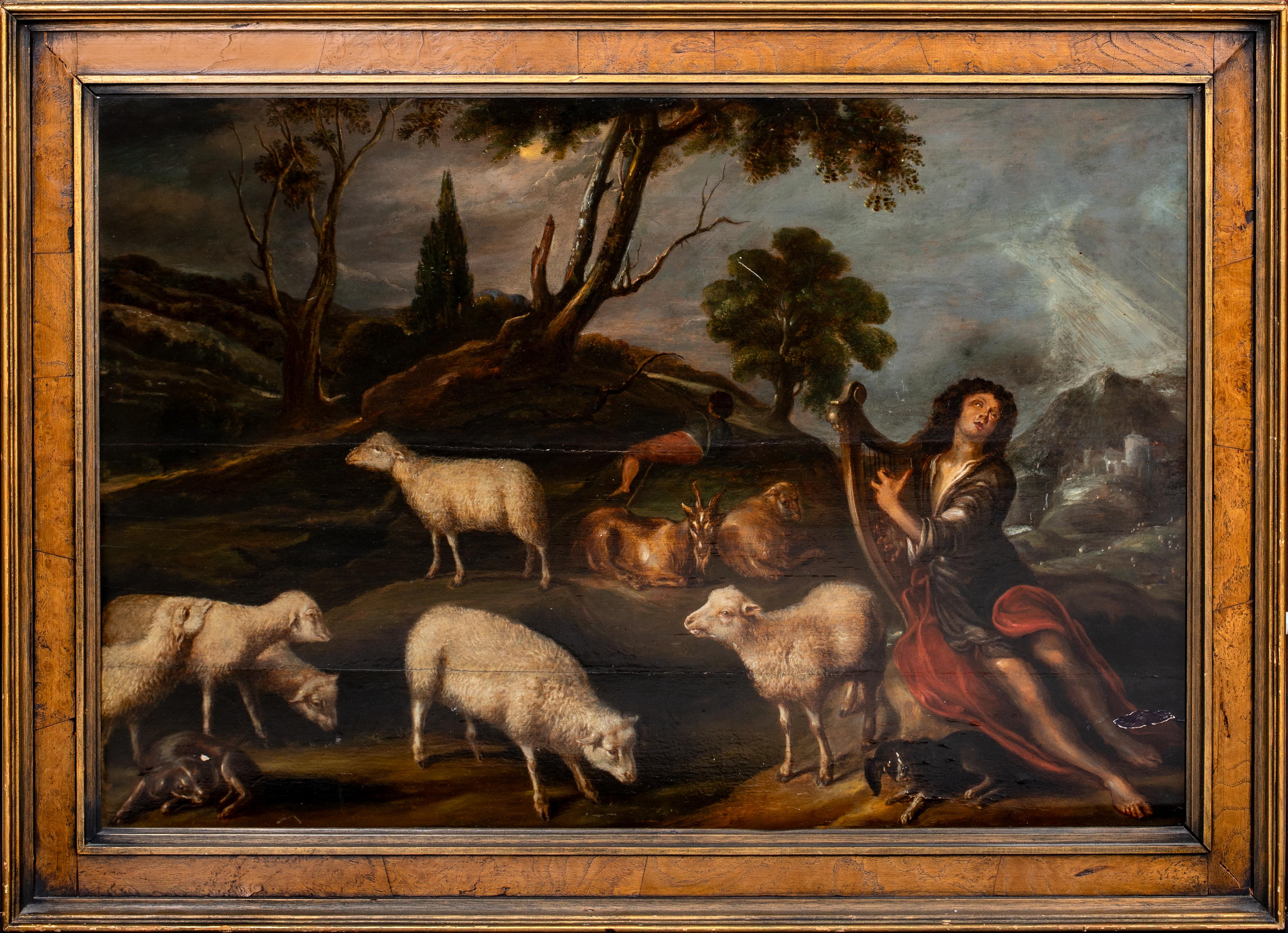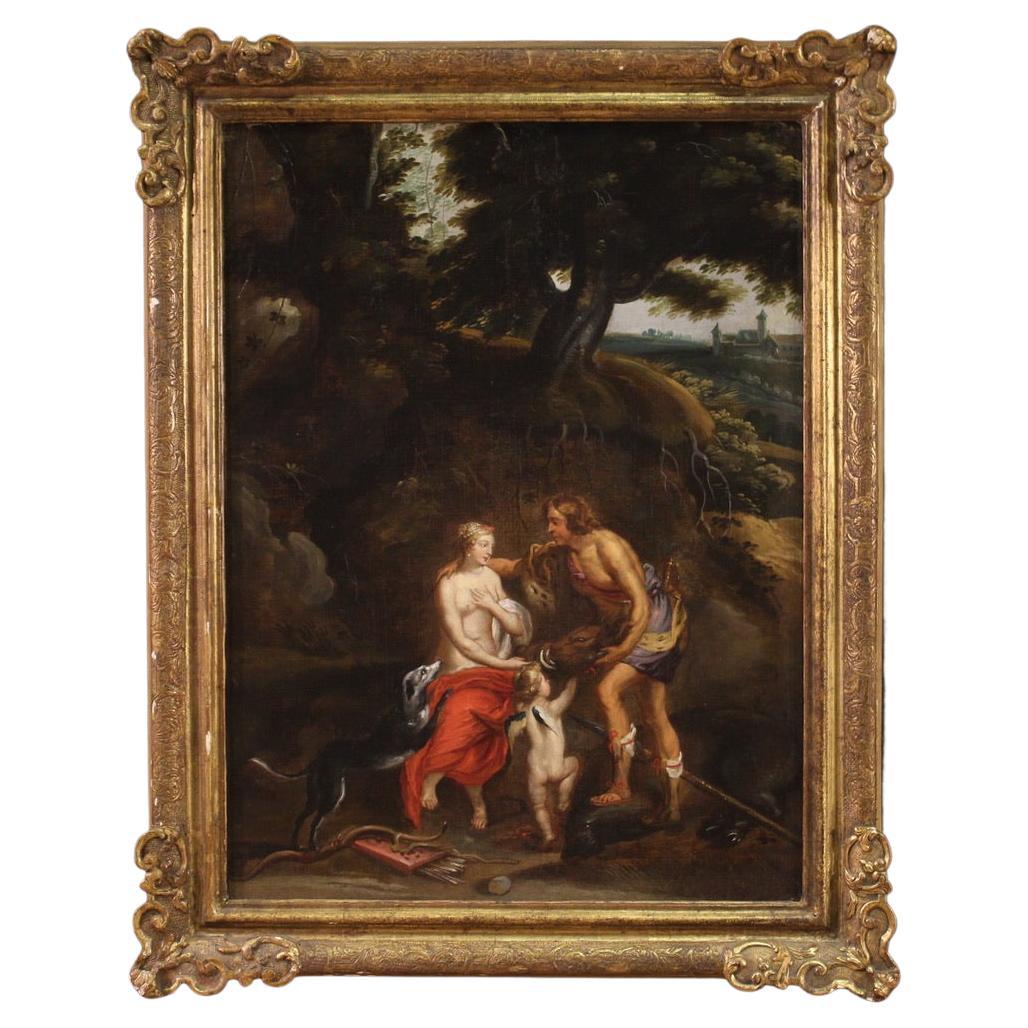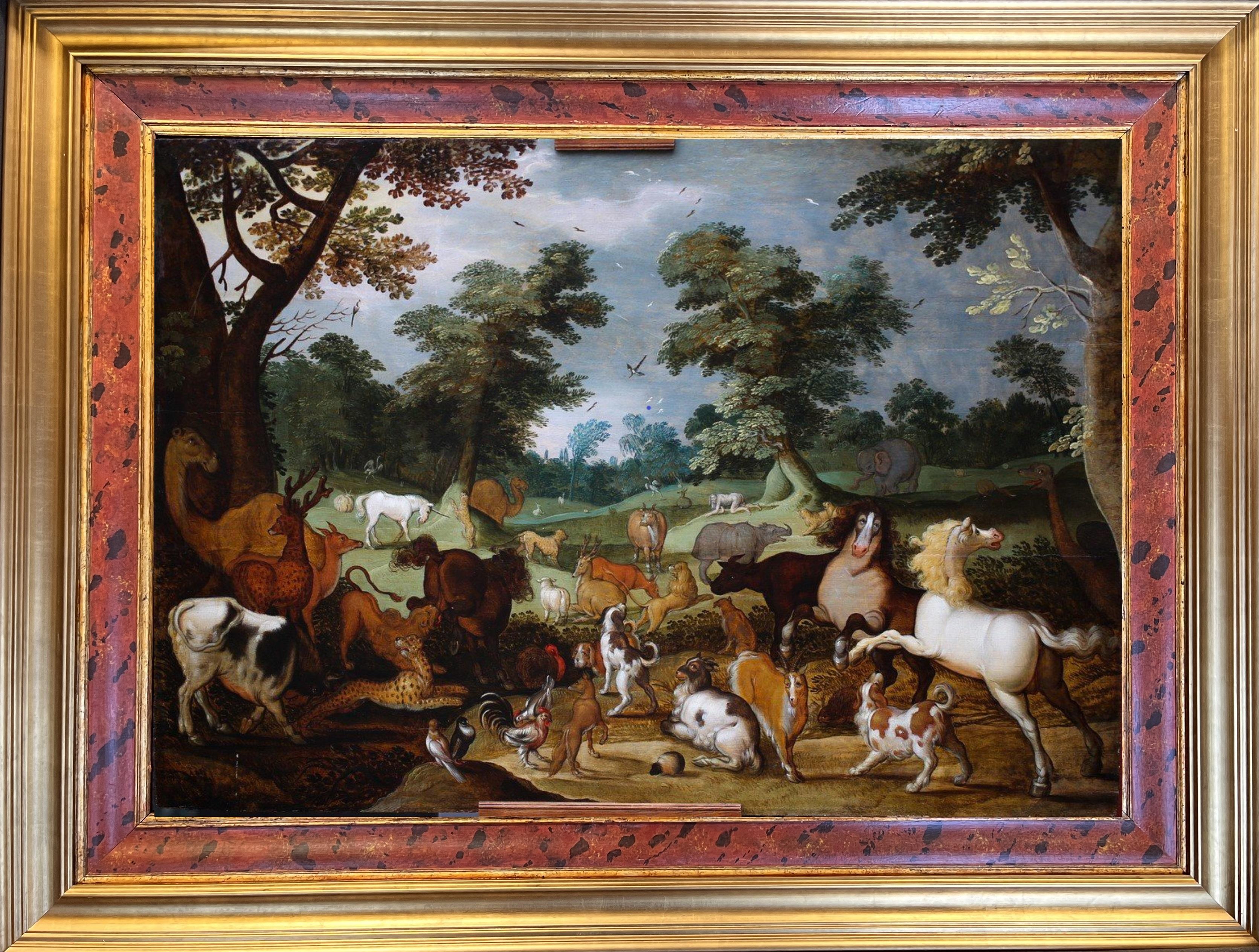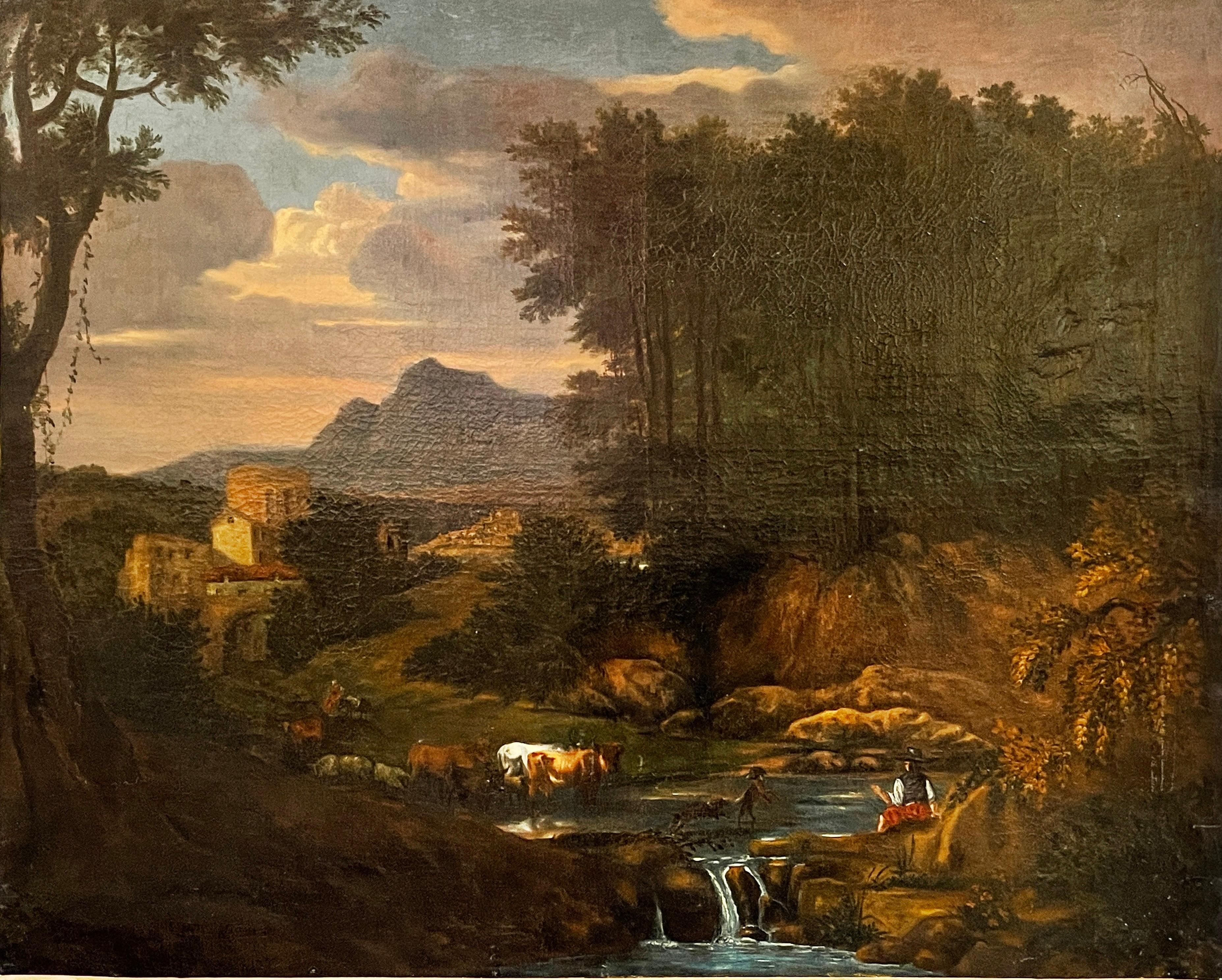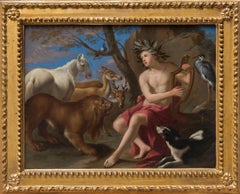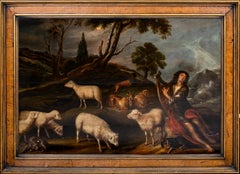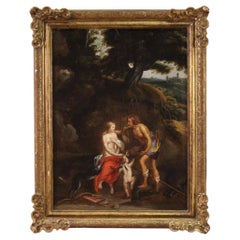Items Similar to Flemish 17th, Orpheus and Animals, Large Decorative Wall Old Master Painting
Want more images or videos?
Request additional images or videos from the seller
1 of 11
UnknownFlemish 17th, Orpheus and Animals, Large Decorative Wall Old Master Paintingc. 1650
c. 1650
$201,558.53
£150,086.93
€170,000
CA$276,952.51
A$309,961.95
CHF 161,776.32
MX$3,779,938.03
NOK 2,070,516.69
SEK 1,960,009.20
DKK 1,294,061.21
Shipping
Retrieving quote...The 1stDibs Promise:
Authenticity Guarantee,
Money-Back Guarantee,
24-Hour Cancellation
About the Item
Flemish school, 17th century
Orpheus and the animals
Oil on canvas, 146,5 x 217 cm
Provenance: South German private collection.
On an impressive, room-filling format, this painting depicts "Orpheus and the Animals."
The harp-playing Orpheus sits centrally in front of a tree whose trunk bifurcates above his head. This central tree frames with its crown the scenery towards the horizon and at the same time offers through branches the possibility for many birds to find space. The left half of the picture is characterized by a seascape, at the edge of which the ruins of a castle can be seen deep in the background. This seascape, framed by mountains on the horizon, is the only area where sky can be seen. On this side, waterfowl such as storks, swans and ducks can be seen. In the right half, the viewer looks into a deep European forest. On this right side, more land animals can be found, such as deer, rabbits and lions, among others. Orpheus wears opulent red and gold trimmed clothing, under his blue breastplate we see a white shirt. His feet are adorned by elaborate sandals. His head is surrounded by a radiant laurel wreath ("poeta laureatus"). The young man is clearly identifiable as the singer and poet of Greek mythology, Orpheus, by his harp, the laurel wreath and the animals surrounding him.
Orpheus was one of the Argonauts who, under Jason, was searching for the Golden Fleece. He sang so beautifully that he even conquered the angry sea and enemies by the magic of his lyre. During the journey, Orpheus is said to have drowned out even the sirens with his singing. It is said that he was the greatest of all poets and charmed people, animals, stones and trees with his singing.
In total, 51 birds and 37 different species are depicted in the painting. The animals are mostly depicted in great detail and, except for a few, can be identified. Mainly European species of animals are shown. Exceptions are the ostrich-like nandu peeking out from behind the deer, as well as the large parrot on the upper left, and the two lions. Similar is the case for the large animal directly behind Orpheus on the right. The shape of the head suggests an arctic fox from the polar regions, even though the body is much too large. The arctic fox was first described in 1555 by Olaus Magnus. However, it could also be a depiction of a brown or black bear.
An unusual detail is the animal, which is relatively isolated in the right background and looks to the left. It is not clearly identifiable, but it shows certain similarities with the Australian kangaroo. This was first described by Vespucci in 1500 and further by Francisco Pelsaert in 1629. If it is indeed a kangaroo, this would be one of the earliest surviving pictorial representations.
In this painting, Orpheus is accompanied by a small monkey playing a viola da gamba. This is an iconographic peculiarity. In general, this painting has some peculiarities compared to other paintings with "Orpheus and the animals". The central positioning of Orpheus is quite common, but he usually holds a lyre and is dressed in an antique style, but not as opulently. The choice of animals is also remarkable: European animals in particular are seen, hardly any exotic features, such as camels or elephants.
The two lions in the right foreground are a quotation from Peter Paul Rubens and his depiction of "Daniel in the Lion's Den", which was realized in an engraving.
The present painting can be classified as belonging to the Flemish School of the 17th century on the basis of its painterly and compositional conception. From the circle of Jan Brueghel the Younger are numerous representations of this Orpheus - theme, which take it as an opportunity to show as many exotic animals. There are also echoes of Spanish painters such as Juan de Arellano or the Italian Sinibaldo Scorza. The composition of the tree landscape is also reminiscent of Jan Brueghel the Younger and Roelant Savery. One must assume that the artist of the present painting knew some representations of Orpheus and combined them here in a kind of capriccio. Moreover, one must assume that he had seen some of the animals either in the original (menageries), as stuffed animals or also in copper engravings. This access and this education alone speak for a creation of the painting in the environment of a court or a highly educated client.
The painting shows 51 birds of 37 species
Upper left corner (20 birds)
Upper row;
Snowfinch Montiffringilla nivalis
Oriole Oriolus oriolus vr ? ?
Eurasian Jay Garrulus glandarius
Kestrel Falco tinnunculus
Second row
Chaffinch Fringilla coelebs
Redstart Phoenicurus phoenicurus
Song Thrush Turdus musicus
Oriole Oriolus orilolus m.
Hoopoe Upupa epops
Third row
4 White Storks Ciconia ciconia
Fantasy parrot / Red winged amazon ? Amazona amazonica
Lesser spotted woodpecker Dendrocopos minor
Fourth row;
Raven Corvus corax
2 Redwings Turdus iliacus
Fantasy song bird, not identifiable
Kingfisher Alcedo atthis
Left below:
Goosander Mergus merganser ?
Black-tailed Godwit (winter plumage?) Limosa limosa ?
Two ducks flying, unidentifiable
swimming:
Garganey Anas querquedula
Great-crested grebe Podiceps cristatus
Little Grebe Tachybaptes ruficollis
2 Swans Cygnus olor juvenile?
Unidenifiable duck
Mallard Anas platyrhynchos
Goldeneye Bucephala clangula f.
Common Scoter Melanitta nigra m.
Unidentifiable duck
Grey heron Ardea cinerea
Purple heron Ardea purpurea ?
White Stork Ciconia ciconia
Upper right
From left to right
Large thrush (cf. drawing in Adriaan Collaert, Gessner / Aldrovandi)
Eagle Owl Bubo bubo
Bullfinch Pyrrhula pyrrhula
Goshawk Accipiter gentilis
Java Sparrow Padda oryzivora
2 Magpies Pica pica
Oriole Oriolus oriolus
Goldfinch Carduelis carduelis
Right in the mid:
Nandu Rhea americana
Ptarmigan Lagopus mutus
Red-legged Partridge Alectoris rufa
Black Grouse Tetrao tetrix
Capercaille Tetrao urogallus f.
Mammals (9 species)
Monkey species
Brown Rat Rattus norvegicus
Rabbit Oryctolagus cuniculus
Red Squirrel Sciurus vulgaris
Red Deer Cervus elaphus
Wallaby Macropus spec. **
Brown / Black Bear Ursus arctos / americana ?
Arctic Fox Vulpes lagopus *** (summer plumage or blue/black form, face correct, body too large)
2 Lions Panthera leo
Amphibians
Frog Rana esculenta ?/ Toad Bufo bufo ?
Tortoise Emys orbicularis ?
Thanks to Ruud Vlek
** first described by Vespucci 1500 en Pelsaert 1629. First depiction ?
*** first described by Olaus Magnus 1555, Aldrovandi 1637, Jonston 1657. First depiction ?
- Creation Year:c. 1650
- Dimensions:Height: 57.68 in (146.5 cm)Width: 85.44 in (217 cm)
- Medium:
- Movement & Style:
- Period:
- Condition:
- Gallery Location:Greven, DE
- Reference Number:1stDibs: LU155029791642
About the Seller
4.8
Gold Seller
Premium sellers maintaining a 4.3+ rating and 24-hour response times
Established in 2011
1stDibs seller since 2021
29 sales on 1stDibs
Typical response time: 4 hours
- ShippingRetrieving quote...Shipping from: Greven, Germany
- Return Policy
Authenticity Guarantee
In the unlikely event there’s an issue with an item’s authenticity, contact us within 1 year for a full refund. DetailsMoney-Back Guarantee
If your item is not as described, is damaged in transit, or does not arrive, contact us within 7 days for a full refund. Details24-Hour Cancellation
You have a 24-hour grace period in which to reconsider your purchase, with no questions asked.Vetted Professional Sellers
Our world-class sellers must adhere to strict standards for service and quality, maintaining the integrity of our listings.Price-Match Guarantee
If you find that a seller listed the same item for a lower price elsewhere, we’ll match it.Trusted Global Delivery
Our best-in-class carrier network provides specialized shipping options worldwide, including custom delivery.More From This Seller
View AllOld Master Painting, Flemish Baroque, Religious Scene, Esau and Jacob, Lentil
By Erasmus Quellinus the Younger
Located in Greven, DE
Isaac and Rebecca had two sons: the twins Esau and Jacob. Esau was the first-born, giving him the birthright. Among Jews the birthright gave the eldest son authority over the family,...
Category
17th Century Baroque Figurative Paintings
Materials
Oil, Panel
Van der Bent, Southern Landscape with woman animals, Dutch Old Master, Berchem
Located in Greven, DE
17th Century Old Master, Figurative and Landscape Painting by Jan Van der Bent
So far, little is known about the life and work of Jan van der Bent. He was...
Category
17th Century Baroque Landscape Paintings
Materials
Canvas, Oil
$17,547 Sale Price
20% Off
Hercules and Omphale, Old Master Painting, Mannerism, Baroque, Mythology, Prague
Located in Greven, DE
Hercules and Omphale
Oil on panel, 52 x 41 cm
According to legend, Hercules had to make atonement and became a slave to the Lydian queen Omphale. When she found out who her slave was, she married him. Falling for his mistress and made effeminate by the luxury of court life, the former hero allowed himself to become the laughing stock of the court. He dressed in women's clothes, spun wool and did other women's work, whereas Omphale wore his lion's skin and carried a wooden club. When the time of punishment was over, the hero realised his delusion and left Omphale.
So far, the painting could not be clearly assigned to an artist. Nevertheless, it impresses with its fluid and convincing painting, whose colourfulness and conception are reminiscent of the Prague School around Bartholomäus Spranger.
This work follows an engraving and an etching made by Michel Dorigny in 1643 after a design by Simon Vouet. It shows the same scene but the print differs in minor details from the present painting (see e.g. the head of the lion) and the treatment of the faces seems to be painted more detailed and refined.
So far there is no painting...
Category
17th Century Baroque Figurative Paintings
Materials
Oil, Panel
Fenzoni, Painting AND preparatorial Drawing, John the Baptist, Italy Renaissance
By Ferrau Fenzoni
Located in Greven, DE
The painting and the preparatory drawing are offered together.
Provenance
Private collection, Germany, Trier, c. 1980- 2013
Saint John the Baptist
Brown ink and wash over red chalk on oatmeal paper
31 x 20.5 cm
Inscribed: „Ferrau Fenzonio da Faenza invt. esque … imp. da Fran. Villamena …“.
bears the collector's mark of Henry Scipio Reitlinger (1882-1950; Lugt 2274a) on a tiny label glued to the verso
On the reverse is a partial drawing of a Pieta, pricked for transfer.
Provenance
New York, Doyle, 14. October 2015, No. 6
The painting and the preparatory drawing resemble the composition of an engraving after Ferraù Fenzoni by Francesco Villamena. Drawing, engraving and painting are almost identical, except for minor differences. Even the measurements nearly correspond: painting (32 x 25,5 cm), drawing (30 x 20,5 cm), engraving (31,1 x 23,5 cm).
Dr. Guiseppe Scavizzi confirmed the attribution of the present panting to Fenzoni and he dates it to c. 1590.
The inscription on the drawing reads “Ferrau Fenzonio da Faenza invt. esque. . . imp. da Fran: Villamena . . .”. The engraving’s inscription also lists place and date “Ferra Fensionius inventor/F. Villamoena sculpsit Rome/Aspectu fruitur… antra puer/cum Privilegio… 1613”.
Interestingly, the engraving is not mirrored as it is in most printing processes. Painting, drawing and engraving are not reversed but the same. It is remarkable to note that there are further paintings by Fenzoni which were engraved in the same order and not reverted. They also show strong parallels regarding the compositions and the measurements (see for example “Deposition of Christ” ).
Ferraù Fenzoni was an Italian painter mainly active in Todi. He is also called Il Faenzone after his birthplace (Faenza). He apprenticed in Rome during the papacy of Gregory XIII and contributed to numerous fresco cycles under pope Sixtus V, such as the Loggia della Benedizioni in the Lateran Palace, the frescoes on the walls and vaults of the Scala Santa of the adjacent Basilica of San Giovanni in Laterano, and the decoration in the Sistine library. His expressive canvases straddle the styles of Mannerism and Baroque. In 1594, he moved to Todi. A “Last Judgement” by him is housed in the cathedral of Todi. He returned to Faenza in 1599, where he decorated chapels in the cathedral from 1612 to 1616. In 1622, he completed a “Deposition”, now in the local Pinacoteca. In 1640, Fenzoni was named “cavaliere dello speron d’oro” by Cardinal Colonna and, on 25th April 1634, he was nominated vicar and “castellano of Granarolo”.
Fenzoni‘s style is characterized by a mixture of the Mannerism of the Northern Netherlands and the Italian Baroque.
Saint John the Baptist, Old Master, 17th Century, By Fenzoni, Religious Scene, Rome Art...
Category
16th Century Mannerist Figurative Paintings
Materials
Canvas, Oil, Handmade Paper
Ferrau FenzoniFenzoni, Painting AND preparatorial Drawing, John the Baptist, Italy Renaissance, 1590
$28,455 Sale Price
25% Off
Southern Landscape with Cows, circle of Both, Dutch 17th Century Old Master
By Jan Dirksz Both
Located in Greven, DE
Circle of Andries Both, Southern Landscape with Cows. Both moved to Italy ( Rome and Venice) where is work was influenced by the warm Italian light.
Decorative Painting
Category
17th Century Baroque Animal Paintings
Materials
Canvas
$3,319 Sale Price
20% Off
Chasseur Fortune, Engraving, Van Falenz / Le Bas, Hunter, Decorative Piece
Located in Greven, DE
Le Chasseur Fortune
Engraving
framed
Bez.: C. Van Falenz pinixit // Jac. Ph. Le Bas Sculp. // a Paris chez Le Bas graveur du Cabinet du Roy au bas de la rue de la Harpe...
Category
18th Century Rococo Animal Prints
Materials
Engraving
$331 Sale Price
30% Off
You May Also Like
Orpheus - Original Oil on Canvas Attr. to Tommaso Salini - Early 17th Century
By Tommaso Salini
Located in Roma, IT
Orpheus is an original artwork realized in the first decades of the XVII century and attributed to the Italian master Tommaso Salini.
Oil painting on canvas.
A golden wood frame is...
Category
Early 17th Century Baroque Figurative Paintings
Materials
Oil
Orpheus Enchanting The Animals, 17th Century Circle of Cornelis Saftleven
Located in Blackwater, GB
Orpheus Enchanting The Animals, 17th Century
Circle of Cornelis Saftleven (1607-1681)
Large 17th Century Dutch Old Master depiction of Orpheus enchanting the animals, oil on panel...
Category
17th Century Landscape Paintings
Materials
Canvas, Oil
Landscape Hunt Miel Paint 17th Century Oil on canvas Flemish Old master
Located in Riva del Garda, IT
Jan Miel (Antwerp, 1599 - Turin, 1663)
attributable
Return from the Hunt
Oil on canvas (51 x 66 cm Framed 74 x 89 cm)
Tous les détails sont disponibles sur le LIEN suivant
The wor...
Category
17th Century Old Masters Paintings
Materials
Oil
$5,795 Sale Price
20% Off
17th Century Oil on Canvas Flemish Mythological Antique Painting, 1660
Located in Vicoforte, Piedmont
A splendid 17th century Flemish painting. Oil on canvas artwork depicting a mythological subject of great charm, Meleager offers the boar's head to Atalanta. The Fates had predicted ...
Category
Antique 1660s Dutch Paintings
Materials
Canvas
$8,536 Sale Price
20% Off
Free Shipping
"Earthly Paradise" Frédérick Bouttats (Antwerp, 1590-1661)- Studio of
Located in SANTA FE, NM
The Earthly Paradise
Frédérick Bouttats (Antwerp, 1590-1661)
Painting is Circa 1610-1612
Oil on wood panel, circa 42 7/8 x 29 3/8 (ca. 52 x 39 frame) inches
The inner frame is c18th ...
Category
1610s Baroque Animal Paintings
Materials
Oil, Wood Panel
Huge 18th Century Italian Old Master Oil Painting Figures & Animals Arcadian
Located in Cirencester, Gloucestershire
The Arcadian Landscape
Italian School, 18th century
oil painting on canvas, unframed
canvas size: 32 x 40 inches
condition: excellent condition for its age, fully restored.
provenance: from a private collection in Paris, France.
Large scale classical 18th century Italian Old Master...
Category
Early 18th Century Old Masters Landscape Paintings
Materials
Canvas, Oil
More Ways To Browse
Flemish Masters
C M Young
Spain Old Masters
Old Master Flemish
Antique Greek Painting
Antique Copper Painting
17th Century Flemish Painting
Old Master Birds
Spanish Baroque Art
17th Century Lion
Baroque Oil Painting Large
Large Monkey
Engraving Flemish
Large Painted Trunk
Antique Red Wing
17th Century German Engravings
Black Swan Antique
Large Gold Elephant
